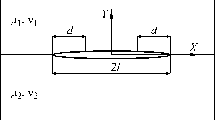Abstract
A mechanical and mathematical model is suggested for an interface crack with bonding in its end zones. Normal and shear bond tractions occurring under the action of the external loads are searched for by solving a system of two singular integrodifferential equations. The stress intensity factors at the crack tip are calculated taking the compensating action of the bonds into account. Energetic characteristics of the interface crack (the deformation energy release rate and the rate of the energy absorption by the bonds) are analyzed. A sensitivity analysis is performed of the force and energetic characteristics of the interface crack to the end zone size, bond compliance and limit stretching.
Similar content being viewed by others
References
Barenblatt, G.I. (1959a). The formation of equilibrium cracks during brittle fracture. General ideas and hypotheses. Axially-symmetric cracks. Journal of Applied Mathematics and Mechanics 23(3), 434-444.
Barenblatt, G.I. (1959b). The formation of equilibrium cracks during brittle fracture. Rectilinear cracks in plane plates. Journal of Applied Mathematics and Mechanics 23(4), 706-721.
Barenblatt, G.I. (1959c). The formation of equilibrium cracks during brittle fracture. Stability of isolated cracks. Connections with the energetic theories. Journal of Applied Mathematics and Mechanics 23(5), 893-900.
Barenblatt, G.I. (1962). The mathematical theory of equilibrium cracks in brittle fracture. Advances in Applied Mechanics (Edited by H.L. Dryden and T. von Karman), Academic Press, New York, 55-129.
Budiansky, B. and Cui, Y.L. (1994). On the tensile strength of a fiber-reinforced ceramic composite containing a crack-like flaw. Journal of Mechanics and Physics of Solids 42(1), 1-19.
Brown, H.B. (1994). Adhesion between polymers. IBM Journal Research and Developments 38, 379-389.
Carpinteri, A. and Massabo, R. (1996). Bridged versus cohesive crack in the flexural behavior of brittle-matrix composites. International Journal of Fracture 81(2), 125-145.
Cox, B.N. and Marshall, D.B. (1994). Concepts for bridged cracks in fracture and fatique. Acta Metallurgica Materialia 42(2), 341-363.
Erdogan, F., Gupta, G.D. and Cook, T.S. (1977). Numerical solution of singular integral equations. Mechanics of Fracture, Vol. 1: Methods of Analysis and Solutions of Crack Problems, 368-425.
Entov, V.M. and Salganik, R.L. (1968). On the Prandtl model of brittle fracture. Inzhenernyi Zhurnal, MTT [J. of Engineering, Mechanics of Solids] (11), 87-99.
Goldstein, R.V. and Perelmuter, M.N. (1996). Interface Cracks with Bonding. Institute for Problems in Mechanics, Russian Academy of Sciences, Moscow, Preprint N 568.
Hong, Ji and de Gennes, P.-G. (1993). Adhesion via connector molecules: The many-stitch problem. Macromolecules 26, 520-525.
Hutchinson, J.W. and Suo, Z. (1990). Mixed mode cracking in layered materials. Advances in Applied Mechanics (Edited by J.W. Hutchinson and T.Y. Wu) 28.
Kurtz, R.D., Farris, T.N. and Sun, C.T. (1994). The numerical solution of Cauchy singular integral equations with application to fracture. International Journal of Fracture 66, 139-154.
Rice, J.R. and Sih, G.C. (1965). Plane problems of cracks in dissimilar media. Journal of Applied Mechanics 32, 418-423.
Rice, J.R. (1988). Elastic fracture mechanics concepts for interface cracks. Journal of Applied Mechanics 55, 98-103.
Rose, L.R.F. (1987). Crack reinforcement by distributed springs. Journal of Mechanics and Physics of Solids 35, 383-405.
Salganik, R.L. (1963). On brittle fracture of glued bodies. Journal of Applied Mathematics and Mechanics 27(5), 957-962.
Segerlind, L.J. (1976). Applied Finite Element Analysis, Wiley, N.Y.-London.
Slepijn, L.I. (1981). Mechanics of Cracks. Sydostroenie, Leningrad.
Weitsman, Y. (1986). Nonlinear analysis of crazes. Journal of Applied Mechanics 53, 97-102.
Author information
Authors and Affiliations
Rights and permissions
About this article
Cite this article
Goldstein, R., Perelmuter, M. Modeling of Bonding at an Interface Crack. International Journal of Fracture 99, 53–79 (1999). https://doi.org/10.1023/A:1018382321949
Issue Date:
DOI: https://doi.org/10.1023/A:1018382321949




